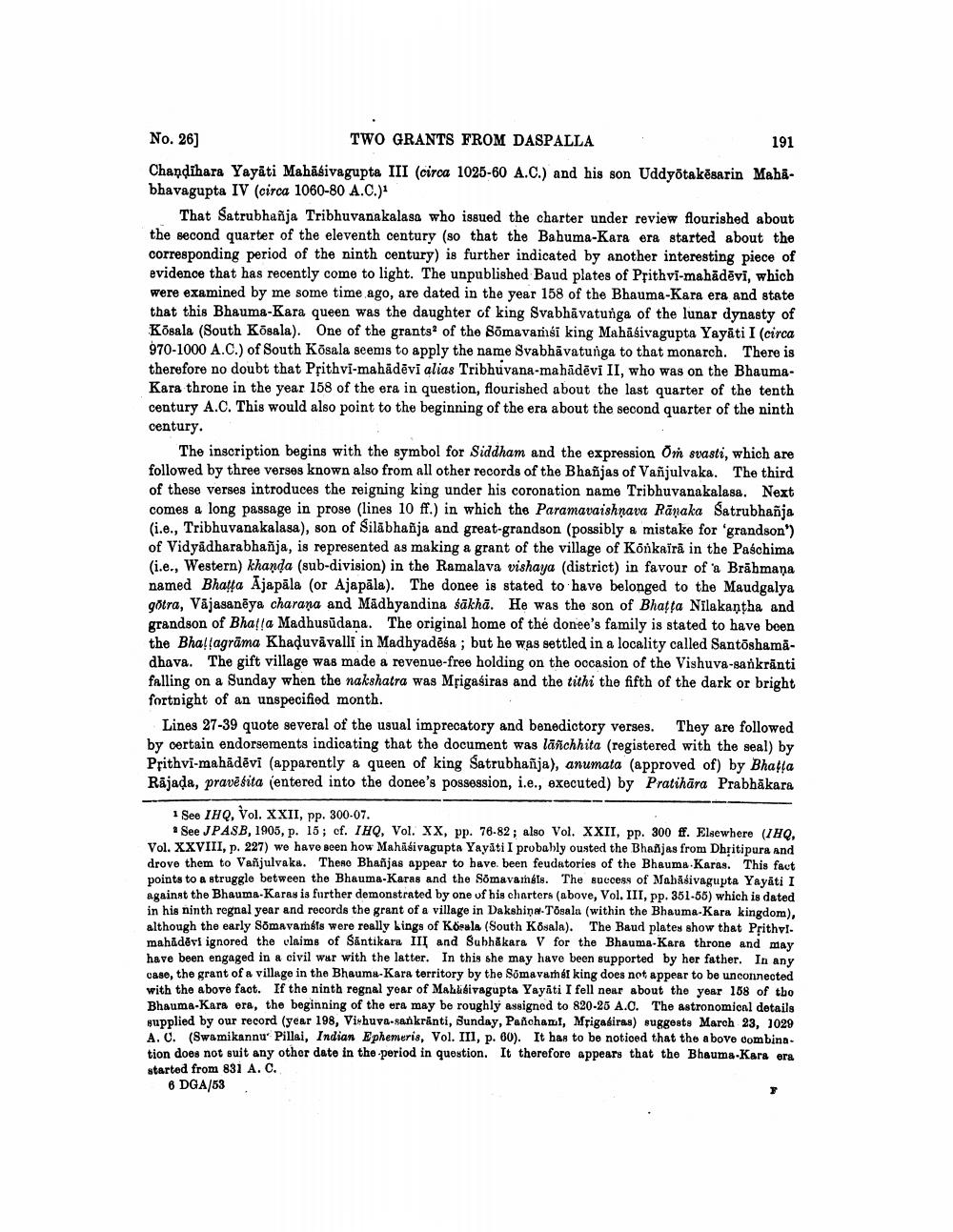________________
No. 26]
TWO GRANTS FROM DASPALLA
191
Chanḍihara Yayati Mahasivagupta III (circa 1025-60 A.C.) and his son Uddyōtakesarin Mahabhavagupta IV (circa 1060-80 A.C.)1
That Satrubhañja Tribhuvanakalasa who issued the charter under review flourished about the second quarter of the eleventh century (so that the Bahuma-Kara era started about the corresponding period of the ninth century) is further indicated by another interesting piece of evidence that has recently come to light. The unpublished Baud plates of Prithvi-mahadevi, which were examined by me some time ago, are dated in the year 158 of the Bhauma-Kara era and state that this Bhauma-Kara queen was the daughter of king Svabhavatunga of the lunar dynasty of Kōsala (South Kōsala). One of the grants of the Somavamsi king Mahasivagupta Yayati I (circa 970-1000 A.C.) of South Kōsala seems to apply the name Svabhavatunga to that monarch. There is therefore no doubt that Prithvi-mahadevi alias Tribhuvana-mahādēvi II, who was on the BhaumaKara throne in the year 158 of the era in question, flourished about the last quarter of the tenth century A.C. This would also point to the beginning of the era about the second quarter of the ninth century.
The inscription begins with the symbol for Siddham and the expression Om svasti, which are followed by three verses known also from all other records of the Bhañjas of Vañjulvaka. The third of these verses introduces the reigning king under his coronation name Tribhuvanakalasa. Next comes a long passage in prose (lines 10 ff.) in which the Paramavaishnava Ranaka Satrubhañja (i.e., Tribhuvanakalasa), son of Silabhañja and great-grandson (possibly a mistake for 'grandson") of Vidyadharabhañja, is represented as making a grant of the village of Kōnkaïra in the Paschima (i.e., Western) khanda (sub-division) in the Ramalava vishaya (district) in favour of a Brahmana named Bhatta Ajapala (or Ajapala). The donee is stated to have belonged to the Maudgalya gotra, Vājasaneya charana and Madhyandina sakha. He was the son of Bhatta Nilakantha and grandson of Bhaṭṭa Madhusudana. The original home of the donee's family is stated to have been the Bhalṭagrama Khaduvavalli in Madhyadesa; but he was settled in a locality called Santoshamadhava. The gift village was made a revenue-free holding on the occasion of the Vishuva-sankranti falling on a Sunday when the nakshatra was Mrigasiras and the tithi the fifth of the dark or bright fortnight of an unspecified month.
Lines 27-39 quote several of the usual imprecatory and benedictory verses. They are followed by certain endorsements indicating that the document was läñchhita (registered with the seal) by Prithvi-mahādēvi (apparently a queen of king Satrubhañja), anumata (approved of) by Bhatta Rajada, pravěsita (entered into the donee's possession, i.e., executed) by Pratihāra Prabhakara
1 See IHQ, Vol. XXII, pp. 300-07.
* See JPASB, 1905, p. 15; cf. IHQ, Vol. XX, pp. 76-82; also Vol. XXII, pp. 300 ff. Elsewhere (IHQ, Vol. XXVIII, p. 227) we have seen how Mahasivagupta Yayati I probably ousted the Bhañjas from Dhritipura and drove them to Vañjulvaka. These Bhañjas appear to have been feudatories of the Bhauma Karas. This fact points to a struggle between the Bhauma-Karas and the Somavamáls. The success of Mahasivagupta Yayati I against the Bhauma-Karas is further demonstrated by one of his charters (above, Vol. III, pp. 351-55) which is dated in his ninth regnal year and records the grant of a village in Dakshina-Tosala (within the Bhauma-Kara kingdom), although the early Somavaméts were really kings of Kosala (South Kosala). The Baud plates show that Prithvimahādēvi ignored the claims of Santikara III and Subhakara V for the Bhauma-Kara throne and may have been engaged in a civil war with the latter. In this she may have been supported by her father. In any case, the grant of a village in the Bhauma-Kara territory by the Somavamál king does not appear to be unconnected with the above fact. If the ninth regnal year of Mahléivagupta Yayati I fell near about the year 158 of tho Bhauma-Kara era, the beginning of the era may be roughly assigned to 820-25 A.C. The astronomical details supplied by our record (year 198, Vishuva-sankranti, Sunday, Pañcham!, Mrigasiras) suggests March 23, 1029 A. C. (Swamikannu Pillai, Indian Ephemeris, Vol. III, p. 60). It has to be noticed that the above combination does not suit any other date in the period in question. It therefore appears that the Bhauma-Kara era started from 831 A. C.. 6 DGA/53




